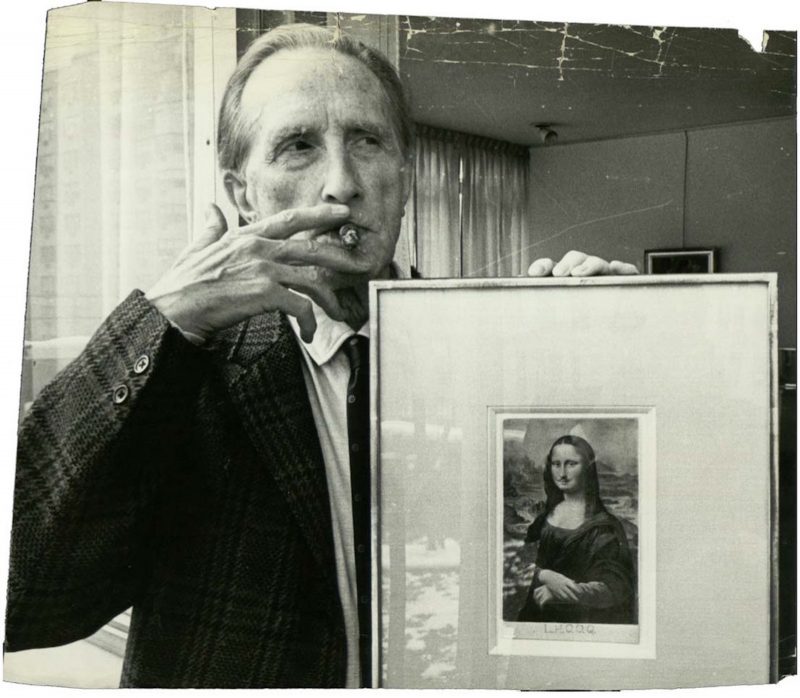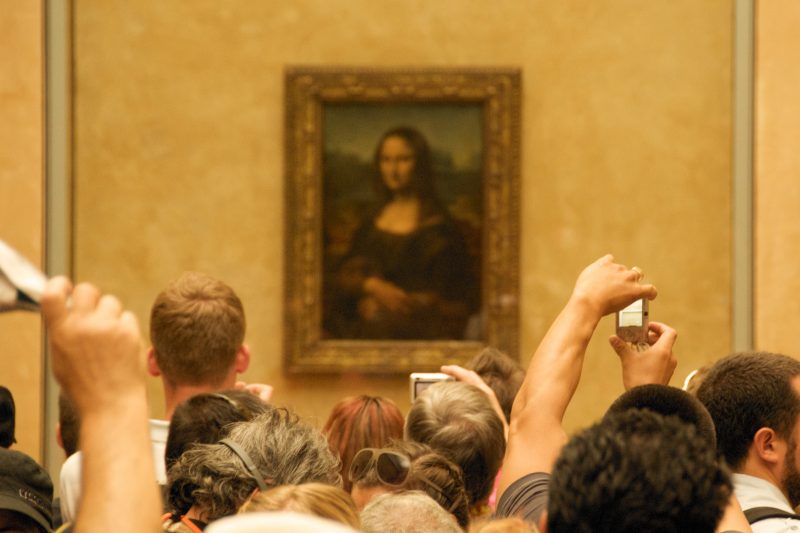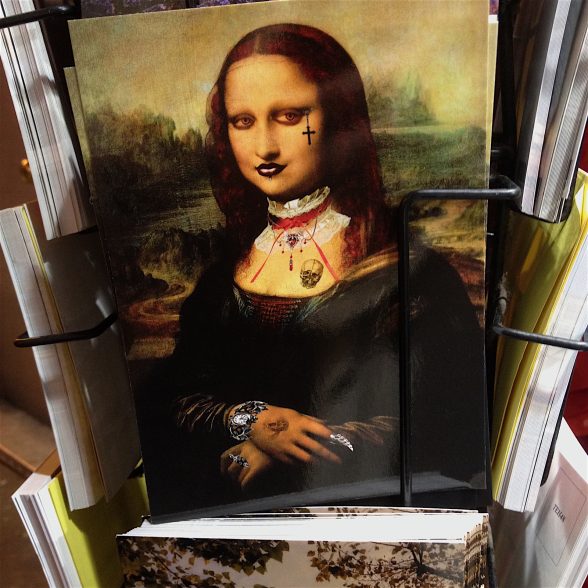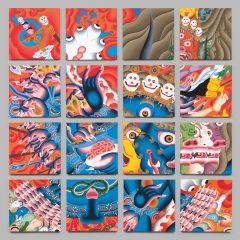Leonardo da Vinci’s 16th century portrait of Lisa del Giocondo measures a mere 77 x 53 cm (30.31 x 20.8 inches), but might be the accidental mother of modernism. Copied, stolen, parodied, the subject of countless books, and millions of reproductions, “La Gioconda” finds itself in endless debates about whether the painting hanging in the Louvre in Paris is authentic or not – or if it even matters. What we do know is the “Mona Lisa” is easily the most well known painting on earth.
While Walter Issacson’s recent tome “Leonardo da Vinci” (2017) lays out the intellectual credentials of the Florentine painter and scientist celebrating da Vinci as the epitome of genius, Dan Brown’s 2003 thriller, “The Da Vinci Code” made millions Leonardo “experts.”
If reproduction of the “Mona Lisa” means anything, it points toward a case history of lust for what seems a distant, erotic mother, a latter day Mary, a contemporary Marilyn. In this light, the Mona Lisa might be the world’s first meme.
Mona Lisa Redux
“La Gioconda” was copied almost from the moment of its creation around 1503 – 1505, most certainly by his studio assistants and notably by Leonardo’s contemporary, Raphael,in 1505. The one we know today came into the French royal collection in 1518, a purchase by Francis l.
The Louvre’s Mona Lisa (“La Jocunde”) found its way into the hands of thieves in 1911. For two years the mystery of the stolen masterpiece stewed in the press, then Louvre employee Vincenzo Perrugia was caught when he tried to unload the Mona Lisa to the Uffizi Galley in Florence. Eventually returned to the Louvre, the artwork began its rising status as the world’s most famous painting.
Enter Marcel & The Meme
But it wasn’t until Frenchman Marcel Duchamp made his notorious pun and doodle on a cheap tourist postcard of La Jocunde that modernism had finally found its sense of humor and fitful 20th century direction.
“L.H.O.O.Q,” Duchamp’s 1919 work where he inscribed those letters on the bottom of the card, then comically added facial hair (mustache and goatee), launched a brave new world. The pun, literally transcribed as pronounced in French – “Elle a chaud au cul” – is translated as “She has a hot ass.” Duchamp offered his own translation: “There is fire down below.”

But Duchamp’s contribution to art history is less about ambiguous sexuality, or even language embedded in an artwork to redirect its meaning, but the powerful notion of the readymade and today’s meme.
The Mona Lisa readymade – Mona Lisa recast with different faces, background scenes, hand gestures and texts – is nothing less than a cottage industry. With no copyright protection, anyone and everyone can get in on the art world’s oldest profession – making copies of the Mona Lisa. Duchamp understood this game quite well.
Remade in 1964 by the artist in an edition of 35, Duchamp’s “L.H.O.O.Q.” was placed in a private collection this past September (2017) by curator-advisor, Todd Levin who offered an auction estimate of the work from between “$600,000 to $800,000.”
Da Vinci’s Mona Lisa traveled from its home at the Louvre to the U.S. in 1963 where it was on view at the National Gallery of Art in Washington, D.C. and the Metropolitan Museum of Art in New York. This U.S. tour allowed the Mona Lisa to make “the epic leap from artwork to icon of mass culture” says Levin. “Duchamp’s desecration of this Renaissance masterpiece is considered the ultimate gesture of iconoclasm – symbolically and effectively terminating Modernism’s attachment to its conservative aesthetic of the past…”

The Desecration Reincarnation
The reincarnation of the Mona Lisa has only accelerated, and in no particular order, here’s a sample of the Mona Lisa universe: Mona Lisa Osama bin Laden, Mona Lisa Hitler, Mona Lisa Groucho Marx with cigar and glasses, Mona Lisa George Washington (on a dollar bill), etc.
Triangulating a meme of four art history warhorses, Mona Lisa pops up on Munch’s existential bridge from “The Scream,” standing next to “Girl with the Pearl Earring” (Vermeer), as van Gogh’s “Starry Night” shimmers in the sky above. “Mona” and “Girl” take a selfie with an iPhone.
Mona Lisa can also be found busy doing bong hits, posing in Grant Wood’s American Gothic, working as a naked secretary, acting as Charles Schulz’s Lucy, sporting an Afro, wearing a combat helmet, picking her nose, and breastfeeding a baby. She’s been made “Time’s Woman of the Year” and portrayed as a film noir hostage, held at pistol point by none other than Vincent van Gogh!
And, no surprise, she is the icon on the most iconic of luxury bags and back packs in collaboration with Jeff Koons, no less. I spied a shelf of Mona Lisa products at Louis Vuitton in Paris, just before Christmas.
With regards to pilfering, I too, am guilty of violating the painting. When in 2014 in Rijeka, Croatia, for an exhibition of my 1000 Queens, I found a large, framed print of the Mona Lisa in a local antique store. I reworked it with text for Duchamp, and made it a centerpiece of my show.
Why so much abuse?
From the failed restoration of a Jesus painting to Munch’s “Scream,” Dali’s “The Persistence of Memory,” and Picasso’s “Guernica,” art works that have evolved to iconic status rapidly accrue abuse. But the Mona Lisa is head and shoulders above these other works.
Why? Perhaps “La Giocoda” scratches an archetypal, psychic itch. The attraction-repulsion might issue from some confused madonna/whore complex seeded deep in our collective, historical culture. Marry this with the lurking, love-hate beast – monetary value – and the virus sweeps across the globe.
Peter Frank, a Los Angeles-based critic and curator, believes that “because the Mona Lisa is the world’s best known artwork, it’s a locus for abuse, as is its subject. It represents ‘art’ and ‘culture,’ a favorite target of the unwashed and/or uncouth. Its ‘mystery’ has been oversold – as has the ‘mystery’ of its painter. All the world hates a genius.”

While Leonardo may have set the whole of modern and contemporary art in motion with the half-smile, half-smirk of his Gioconda, one result is the Mona Lisa became the most valuable painting in history, worth in excess of $800 million, according to its inflation-adjusted 1962 insurance valuation.
But it could be worth more. In November 2017 a painting ascribed to Leonardo, “Salvator Mundi,” sold at Christie’s for $450 million. That work was kept largely hidden from the public. The Mona Lisa, permanently on display at the Louvre since 1797, is one of the main reasons people travel to Paris and pay the 15 euro ($18) entrance fee to the world’s largest museum.
With Leonardo’s genius we get the most mocked, copied, manipulated and expensive work of art known to man. The source of tasteless jokes, visual puns and aesthetic theories on value, sex, the nature of art itself looks out from her 16th century world, a half-smile permanently plastered to her impossibly impenetrable face, not exactly asking what the fury is all about, because, obviously, she knows.









